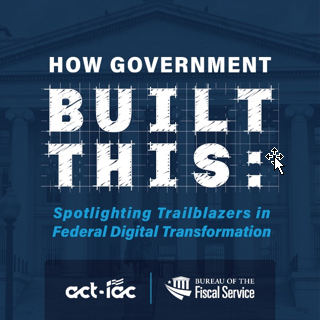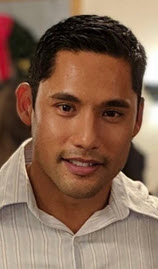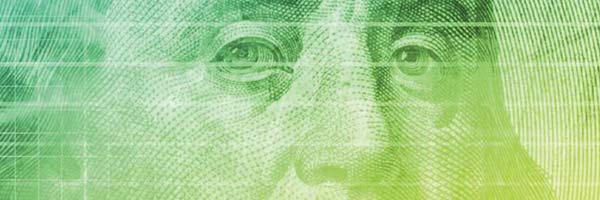

'How Government Built This' Innovation Spotlight: Cyber's Elite Forces – How Air National Guard Puts People First with Artificial Intelligence to Drive Digital Transformation

Welcome to “How Government Built This,” a six-part podcast and blog post series developed by the Department of the Treasury’s Bureau of the Fiscal Service Office of Financial Innovation and Transformation (FIT) in collaboration with the American Council for Technology and Industry Advisory Council (ACT-IAC) a non-profit educational organization established to improve government through the effective and innovation application of technology. This series spotlights trailblazers in Federal digital transformation. Resources and links mentioned in each podcast will also be available at actiac.org/thebuzz.
Lieutenant Colonel (Lt Col) Andrew Wonpat
 Lt Col Andrew Wonpat enlisted in the U.S. Naval Reserve (USNR) in the cryptologic field, commissioned into the active-duty Army Signal Corps, and then joined the Air National Guard's (ANG's) 175th Network Warfare Squadron. His military career is dominated by cyber operations and various staff assignments.
Lt Col Andrew Wonpat enlisted in the U.S. Naval Reserve (USNR) in the cryptologic field, commissioned into the active-duty Army Signal Corps, and then joined the Air National Guard's (ANG's) 175th Network Warfare Squadron. His military career is dominated by cyber operations and various staff assignments.
Andrew's current military assignment is as a Cyber Capabilities Development Strategist with U.S. Air Force (USAF) Futures, with the mission of exploring non-traditional force structure and future cyber capability development. He also served as Director of Joint Information Warfare at the Joint Artificial Intelligence Center (JAIC) where he stood up the Cyber, Information Operations, Electromagnetic Spectrum Operations, and Space Operations Mission Initiatives. Prior to that, he was the commander of a cyberspace operations squadron providing capabilities to USCYBERCOM.
Andrew also leads the ANG's Cyber Decision-Cognitive Assessment Readiness System (CYDE-CARS) program which uses machine learning, cognitive, & biophysical markers to identify and assess personnel who demonstrate a higher propensity of successfully passing the Department of Defense’s (DoD's) most rigorous cyber training. Andrew worked with military and industry leaders in human performance to develop high performing cyber teams focused on trust, creativity, and critical thinking. Additionally, he leads the Critical Infrastructure and Key Resources (CIKR) team for the 175th Cyberspace Operations Group.
In his industry role, he was a Systems Engineering and Technical Assistance (SETA) representative on the Defense Advanced Research Projects Agency (DARPA) Rapid Attack Detection, Isolation, and Characterization Systems (RADICS) program and Satellite Communications (SATCOM) engineer supporting Defense Information Systems Agency (DISA) and the Department of State.
Why is digital transformation more than just advancements in technology?
Andrew emphasized a different approach to digital transformation and emerging technologies with people being the focus. He highlighted that digital transformation comes from people and teams who bring ideas to the table that push the digital landscape forward. He emphasized that people play a major role in digital transformation and people’s cooperation is at the heart of innovation. This is the foundation of the CYDE-CARS initiative, finding those quality candidates, and Andrew noted that this should be the first step in leveraging emerging technologies to bring people together to accomplish an agency’s mission goals and objectives. Technology will always play a role in digital transformation, but Andrew’s perspective is that putting people first builds a stronger workforce which drives innovation across Federal agencies.
How do you build high performing teams in government?
Andrew outlined that teams are typically built organically with some level of assessment of the individuals and the skills they currently possess. One challenge faced today though is that building a high performing team outside of the special operations construct has never been codified. There is no precedent or objective metrics that enable an organization to optimize their resources to build and develop that team.
In pursuit of codifying the process of building a capable workforce, he sought out feedback and guidance from academia, industry representatives, neuroscientists, elite sports teams, and special operations to understand how to build teams who can operate at high level. Through this exercise, he identified various similarities across the organizations, which he then distilled and applied to the creation of teams through the CYDE-CARS initiative.
Currently, Andrew noted that teams must be organized, well-trained, and equipped with the tools and skills necessary to reach high-performance levels. The CYDE-CARS initiative aims to move ahead of that process and provide additional objective metrics to assess people’s traits that would make them successful on a high performing cyber-team.
What did you decide to focus on first and how does CYDE-CARS incorporate Diversity, Equity, Inclusion, and Accessibility (DEIA) principles?
Andrew outlined the number one limiting factor for the CYDE-CARS initiative is there is not enough representation across the initiative for women and minorities. To address this, he noted that CYDE-CARS is partnering with different organizations to collaborate on sharing data and information to address this challenge. Andrew also asked for audience suggestions on how more diversity can be included in an initiative like CYDE-CARS, especially when it comes to assessing who will be successful.
Andrew mentioned one current example for how he is hoping to bring more diverse audiences to initiatives like CYDE-CARS is through an event called Thunder Pass. At Thunder Pass a race car will be driven in a tunnel upside down unassisted using nothing but physics. He noted that the audience this event attracts creates an opportunity for people who may have never known the military provides training on such diverse STEM professions which can be applied to a post-military career.
By participating in events like Thunder Pass, this helps bring diverse people with diverse backgrounds in art, science, and military together to find common interests and identify people who may perform well on elite teams.
What are the challenges an organization may face in adopting new initiatives? How do you overcome these challenges?
Andrew's first challenge was articulating the vision of how this program could best be leveraged. For organizations to adopt this program, he made it a priority to educate senior leaders on the benefits of CYDE-CARS. A few of the challenges he identified through developing this initiative were adequately communicating its benefits and obtaining senior leader buy-in up front.
Andrew outlined that CYDE-CARS continues working toward producing its long-term result, but it immediately allows an organization to make data-informed decisions by providing objective data where none existed prior. Some of the solutions to overcome adopting innovative solutions is clearly articulating the benefits not just to the direct problem of the senior leader but one level above and below the leader. Additionally, the ability to understand and articulate how to minimize any resourcing impact goes a long way in garnering decision leader support.
Advice for readers
Across government we look for ways to achieve a complete digital transformation. Why? Andrew emphasized the reason we are so hungry to achieve a digital transformation is to make the process and our work-flows easier to maintain with the end goal of producing a better output. He highlighted that human centered design must be at the heart of every innovation.
If a new tool or process adds too many extra steps for the end user, then organizations will face several challenges in adoption no matter how great the output may be. He noted that transformation is about the people, internal and external. The people who consume the data or output of an innovation are just as important as the people who created it. Lastly, Andrew stressed that a quality culture fosters an environment that allows for a digital transformation that people can trust.
CYDE-CARS is open to agencies across government. For more information on CYDE-CARS, please reach out to Lt Col Andrew Wonpat at andrew.r.wonpat.mil@mail.mil.
References
- For more information on ACT-IAC’s Emerging Technology Accelerator, please reach out to Jackie French at jfrenc27@alumni.jh.edu.
- ACT-IAC Emerging Technology Community of Interest (COI) "People as the Strongest Link: Emerging Trends in Human Centered Design and Customer Experience Approaches for Cybersecurity" June Monthly Meeting.
- ACT-IAC Use Case Summit taking place on September 20, 2022, from 9 AM to 12 PM at the General Services Administration’s headquarters and online.
- ACT-IAC Cybersecurity Forum 2022 taking place on October 12, 2022, from 8:30 AM to 2:30 PM at the Renaissance Washington, DC, Downtown Hotel.
